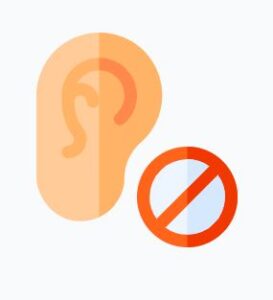What is deafness?
Hearing Loss – Four Levels of Severity: Mild, Moderate, Severe, and Profound
According to the World Health Organization, deafness is classified as profound hearing loss.
Prevalence: 0.35% of people are born with or acquire profound hearing loss
Possible Causes:
- Genetic
- Sickle cell disease
- Down syndrome
- Non-genetic
- Premature birth
- Maternal diabetes
- Maternal infection
- Ear malformation
- Infections later in life ie. meningitis
- Traumatic brain injury
- Noise exposure

Verbal Communication
- At infancy, children who are deaf are unable to access the auditory linguistic input that their adult communicative partner provides, resulting in:
- Difficulties with phonological and morphological awareness and production
- Examples: sound repertoires, pitch, and tongue positioning.
- Limited lexicon due to less accessible vocabulary.
- Difficulties with phonological and morphological awareness and production
- Children who are congenitally deaf often have little to no concept of verbal language without intervention.
- Children who are deaf are at high risk for language deprivation.
Therefore, intervention and/or some sort of alternative method for language learning besides auditory-only communication are integral to prevent this detriment; prioritizing accessible linguistic input is key.

ASL
Sign languages are often used to communicate among individuals who are deaf. Like language development for children with typical hearing, children who are deaf need language input. However, because of their lack of hearing, this input is typically in a form of sign language. In the United States, ASL is the most common sign language. The video below is an example of common ASL phrases.
Written Communication
- According to the National Association of the Deaf (NAD), many individuals who are deaf communicate with a sign language and a spoken language.
- For Example: American Sign Language (ASL) and English
- Therefore, when writing they use their spoken language, because sign languages do not have popularized written components.
- Because of this, writing is essentially a bilingual process!
This effects
- Phonological awareness
- Reading comprehension
- Spelling
- Producing writing
Ultimately, children who are deaf need an understanding of spoken language in order to build their literacy skills.

Types of Interventions
While children who are deaf are at a high risk for language deprivation, they are still fully capable of achieving proficiency in expressive and receptive language as long as they are provided some sort of linguistic input.
Techniques range from total reliance on auditory input (spoken language) to total reliance on visual input (sign language;) in the middle of this continuum is the bimodal bilingual methodology.

Bimodal Bilingualism
- Consistent access to both rich ASL and English printed language
- Gallaudet University described an additive approach to bimodal bilingualism.
Additive approach:
Visual (sign language) + Spoken (English) = Strengthening both languages!
Verbal Interventions
- While the auditory-only and sign-only sides of the debate are quite polarized, the two need not be mutually exclusive.
- It is important to consider that while speech is not a necessary prerequisite for healthy development, proficiency in at least one language is fundamental.
- Bimodal bilingualism ensures proficiency in at least one language while giving the opportunity for and encouraging both languages to grow.
Written Interventions
- Teaching to a curriculum with components of ASL and English led to the highest learning outcomes for individuals who are deaf.
- Writing, because it is a largely bilingual process for individuals who are deaf, is positively impacted by bimodal bilingual methods in education.
- Early intervention is key for this approach to work, as the child is learning both languages closer to the critical period.
- The further intervention is from the critical period, the more susceptible a student who is deaf is to a written language attainment gap.
- This is due to higher fluency in their visual language than their spoken language, making it more difficult for successful written production because of language interference.
Education
- Begins with early introduction to regional sign language
- Working with professionals both fluent in sign and experts in structures and overall acquisition
- Individualized Planning:
- Link current abilities in both sign language and spoken language to important language milestones and their own unique needs.
- Examples of unique needs:
- Families who are culturally deaf
- Whether family signs
- Have comorbid disabilities
- Use of hearing aids or cochlear implants
- Teacher and school planning must support this type of learning
Video
Where We Got Our Pictures and Information
Pictures: https://www.flaticon.com/, https://www.freepik.com/, https://www.clipartmax.com
Video:
Vicars, Bill. (2013). American Sign Language (ASL) “Phrases” (01). Youtube. www.youtube.com/watch?v=INaTN47eOCs
Information: www.who.int/, https://www.gallaudet.edu, www.cdc.gov, https://www.nad.org
Additional References
Alamargot, D., Morin, M., & Simard-Dupuis, É. (2018). Handwriting in signing deaf middle-school students and relationship with text composition and spelling. Reading and Writing, 31(4), 1017-1038. http://dx.doi.org.proxy.library.vanderbilt.edu/10.1007/s11145-018-9824-y
American Speech-Language-Hearing Association. (2020). Permanent Childhood Hearing Loss. https://www.asha.org/practice-portal/clinical-topics/permanent-childhood-hearing-loss/
Centers for Disease Control and Prevention. (2020, June 8). How people with hearing loss learn language. www.cdc.gov/ncbddd/hearingloss/language.html
Centers for Disease Control and Prevention. (2020, June 8). Types of Hearing Loss. www.cdc.gov/ncbddd/hearingloss/types.html
Dammeyer, J., & Marschark, M. (2016). Level of educational attainment among deaf adults who attended bilingual–bicultural programs. Journal of Deaf Studies and Deaf Education, 21(4), 394-402. http://dx.doi.org.proxy.library.vanderbilt.edu/10.1093/deafed/enw036
Davidson, Katherine, Lillo-Martin, Diane & Pichler, Deborah Chen. (2014). Spoken English language development among native signing children with cochlear implants. Journal of Deaf Studies and Deaf Education, 19(12), 238-250. www.ncbi.nlm.nih.gov/pmc/articles/PMC3952677/
Goman, A. M., & Lin, F. R. (2016). Prevalence of Hearing Loss by Severity in the United States. American journal of public health, 106(10), 1820–1822. doi.org/10.2105/AJPH.2016.303299
Hall, Matthew L., Hall, Wyatt C., & Caselli, Naomi K. (2019). Deaf children need language, not (just) speech. First Language 39(4), 367-395. http://journals.sagepub.com/doi/10.1177/0142723719834102
Humphries, Tom, Kushalnager, Pooja, Mathur, Gaurav, Napoli, Donna Jo, Padden, Carol, Rathmann, Christian & Smith, Scott R. (2012). Language acquisition for deaf children: reducing the harms of zero tolerance to the use of alternative approaches. Harm Reduction Journal 9(16). www.ncbi.nlm.nih.gov/pmc/articles/PMC3384464/
Kyle, F. E., Campbell, R., & MacSweeney, M. (2016). The relative contributions of speechreading and vocabulary to deaf and hearing children’s reading ability. Research in Developmental Disabilities, 48, 13-24. http://dx.doi.org/10.1016/j.ridd.2015.10.004
Lederberg, A. R., Miller, E. M., Easterbrooks, S. R., & Connor, C. M. (2014). Foundations for literacy: An early literacy intervention for deaf and hard-of-hearing children. Journal of Deaf Studies and Deaf Education, 19(4), 438-455. http://dx.doi.org.proxy.library.vanderbilt.edu/10.1093/deafed/enu022
National Association of the Deaf. (2020). National Association of the Deaf. https://www.nad.org/
Nussbaum, Debra B., Scott, Susanne & Simms, Lauren E. (2012). The “why” and “how” of an ASL/English bimodal bilingual program. Odyssey: New Directions in Deaf Education 13, 14-19. https://www.gallaudet.edu/Images/Clerc/articles/Odyssey_SPR_2012_NussbaumScottSimms.pdf
Shojaei, Elahe, Jafara, Zahri, & Gholami, Maryam. (2016). Effect of Early Intervention on Language Development in Hearing-Impaired Children. Iranian Journal of Otorhinolaryngology, 28(1), 13-21. www.ncbi.nlm.nih.gov/pmc/articles/PMC4735612/
Vlastarakos, Petros V. (2012). Profound deafness and the acquisition of spoken language in children. World Journal of Clinical Pediatrics, 1(4), 24-28. www.ncbi.nlm.nih.gov/pmc/articles/PMC4145645/
World Health Organization. (2020). Deafness and Hearing Loss. www.who.int/news-room/fact-sheets/detail/deafness-and-hearing-loss
